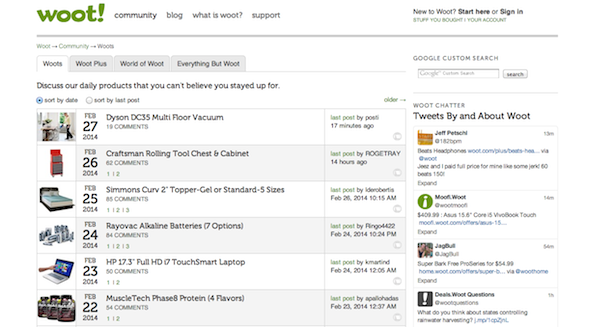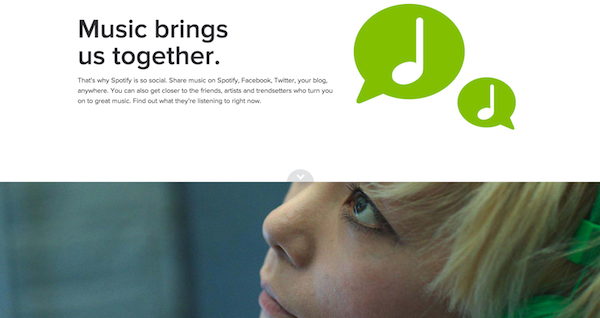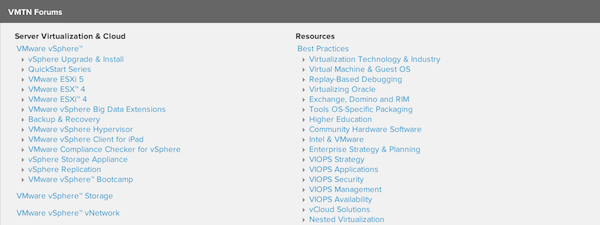It seems to be a truism that businesses need to get social, but what does that mean? Sites today are littered with buttons to facilitate users sharing on Facebook, Twitter, Reddit, Tumblr, and a host of other sites. Similarly, many companies also have their own accounts on various social networking sites and do all they can to get likes and followers for the content that they post there.
While these approaches can be an integral part of an overall customer experience strategy, it’s important to consider the wisdom in surrendering the majority of social interactions to third party sites. There is an alternative. Fostering communities within the walls of a businesses website can pay tremendous dividends and be one of the most impactful dimensions of the overall user experience. Commercial websites that cultivate a community within their user experience can develop relationships with consumers that go beyond the transactional and reach into the realm of emotion and identity—far more powerful and compelling levels of interaction.
This article shares four case studies of websites leveraging the power of communities to positively impact user experience. From stickiness and user feedback to tech support and improving the efficacy of calls to action, developing digital communities can offer tremendous benefits beyond just the brand awareness gained through a Twitter account or Facebook page. There are, of course, potential pitfalls and best practices for those interested in pursuing this strategy so we’ll take a look at those as well.
The Power of Communities
First, let’s step back and take a look at the underlying dynamics that allow social interactions to have such a strong impact on user experience. The web is playing an ever-increasing role in human interactions. Digital communities shape our worldview and give us a bevy of new opportunities to meet one of the most basic of human needs: social interaction.
From the earliest days of the net, users formed networks and communities around their hobbies, passions, and professions (these types of groups are often referred to as “communities of interest”). While Facebook and Pinterest grab headlines today, many an old school message board and e-mail list chugs along providing tremendous value for participants, especially in niche and specialized topics. The valuations of the former and longevity of the later speak to the tremendous impact and power of digital communities.
From the earliest days of the net, users formed networks and communities
It is often through communities, after all, that we develop a fundamental sense of who we are and discover our place in the world. Seeking out both like-minded collaborators and interlocutors with different world-views are powerful forces in the development of our own self-identity. When thinking about large, complex issues, it is also common that the insight we can glean from communities is far greater than the sum of its parts. The Internet is at its most powerful when it allows users to mediate their identity and experience in a way that is evocative and not just operational.
With that said, it is important to recognize that there is tremendous variation in the organization and dynamics (i.e., the culture) of online communities and not all the components will benefit the user experience of websites equally. Recognizing the appropriate value to deliver to users through their social experience is essential to ensure that experience resonates with them in a meaningful way.
Woot!: We’re in this together!
Woot! is a popular daily deal cyber retailer. What differentiates it from competitors is the loyalty of the users, which has been incubated through the several community aspects on Woot! The site encourages users to leave comments on that day’s deal creating a feel of a team of like-minded people trying to assess just how good the deal is. Users share their experiences with the product and post links to third party reviews for others to read.

The website also does a great job of reinforcing the social aspects of the experience by sharing how well the sale is doing along with other points of data (states where the most sales are coming from, what percentage of buyers bought multiples, etc.). Knowing that others in the community are jumping on the sale can give users more confidence in making a decision to purchase. This, coupled with the time constraints of the sale, help to foster a sense of excitement.
The camaraderie engendered by this process keeps people engaged and coming back to the site day after day and also helps to create a very favorable impression of the website. The social experience is not purely transactional, but starts to even be a part of users’ identities (they call themselves “wooters”). Users come to the site not only for the deals, but because the interaction is fun. This model fits very well for a site that is not designed for people to seek out specific products, but rather to find deals on items they may not even have known they wanted.
While the tone of the site is definitely set by the funny and breezy copy used to introduce the products, the site gains great value add from user generated content and involvement, which requires relatively little investment from Woot! itself.
Spotify: The community speaks!
Spotify is a cloud-based music streaming platform accessed primarily through a desktop or mobile app. Their business model is based on users paying a monthly membership fee. While the app relies primarily on Facebook to identify which of your friends are users, Spotify takes this a step further and helps users to see what they are listening to and share playlists. Ultimately this helps users stay engaged and excited about the product, discover new content, and remain loyal to the service. While, in theory, another service might have a better catalog of music, the social community component of Spotify helps to ensure a degree of stickiness for users.

Beyond the app, Spotify has also developed a strong social component in their online message board, the “Spotify Community,” which generates considerable user traffic on its own. This forum is a goldmine for finding out issues with the current user experience on the website and identifying potential unmet user needs, giving a way to jump-start improvements, innovations, or redesigns.
VMware: Let’s help each other!
A company that creates cloud infrastructures, VMware also recognizes that their forums offer a fantastic resource for understanding how users are using their services. As users submit tickets for technical support the encouraged to consult the forums to see if that knowledge base already has answers to their questions. This can greatly reduce the need for technical support in general and provide answers faster than waiting for support. It also has the advantage of providing highly specialized or idiosyncratic advice that only a very sophisticated technical support person might be able to answer, if at all.

From the user perspective, being able to answer questions of less-experienced users can be quite satisfying. This validates their expertise and keeps them motivated to keep using the product. Similarly, for many VMware users, the forums provide an important social component for a job that can otherwise be quite solitary. Lastly, the forums provide a valuable resource for users to stay abreast of developments and can help them to more clearly make the case to those who control the purse strings about the necessity of upgrades.
ModCloth: Let’s share inspiration!
One of the challenges many online only clothing retailers face is giving users the confidence that the items they are buying have the correct fit and style. While easy returns are a critical piece in overcoming hesitation, helping users make the right decision in the first places benefits both users and the retailer. ModCloth tackles this problem by creating a rich social community. They encourage users to join their community and submit pictures of themselves wearing ModCloth clothes to the “Style Gallery.”

The Style Gallery not only helps potential customers to see what the clothes look like in real life, but also offers inspiration for outfits and combinations, which can encourage users to purchase. For those who submit photos, getting positive feedback from the community helps to foster brand loyalty. Dedicated users are featured on the website and designated “Style Gallery Superstars.” Keeping this on their website, rather than Facebook, allows the company to moderate the community to ensure a positive tone and integrate the offers more closely with purchasing opportunities.
Implementation
These are just a few examples of companies cultivating social communities to enhance the user experience. While social communities can be a user experience asset, they are a big undertaking that shouldn’t be taken lightly. There are a few planning considerations and best practices to keep in mind:
Considerations
- Trust. Once it is lost it is very difficult to get it back, so it is important that users feel respected and not manipulated. Clear and transparent privacy policies are an important component.
- Moderation. Maintaining a civil and positive feel is of vital importance. Users on the VMware site don’t want to be belittled and users submitting their images to the ModCloth Style Gallery don’t want to be made fun of. Empowering users to maintain the climate can be a useful tactic and moderation definitely requires a light touch, but if the overall experience is not positive users will not want to participate.
- Similarly, these kinds of communities can be a forum for people to gripe about the company or services it offers so the company must be prepared to take the criticisms in stride and see them as an opportunity for important and free feedback rather than potential bad publicity.
- Beware the Trolls! Before actively pursuing a social strategy (either on Facebook or within a site experience), it is important to have clear policies and protocols for how to deal with both individual and organized group trolling efforts. While established communities are often able to shrug such disruptions off, it can be more difficult for newer communities to deal with such attacks as the level of trust and value has not been as firmly established.
Best Practices
- Empower your community. Users respond when they feel like they can have an impact. Many a comments section on website lays unused because the reward for leaving comments is so negligible. Think about what role users can play.
- Gamify. Even if they are just “internet points” adding rewards and scores can be an important way to encourage participation.
- Recognize Social Hierarchy. It is important to reward your particularly active and loyal users. Often a relatively small percentage of the user base plays a disproportionate role in maintaining the culture and quality of communities. Reward them for their dedication (e.g., highlighting someone as a “power user”) and recruit them to be moderators.
- Trust your users. While the internet can sometimes seem to be full of malcontents and trolls, users will often not want to participate in communities that seem to restrictive or censored. Take complaints as the first step in your next round of user testing.
Conclusion
Online communities are as varied and diverse as those offline—in fact the lines between the two are becoming quite blurred. Recognizing your users’ instincts toward, and need for, social interaction can play a critical role in providing a meaningful user experience. Meeting users at this level can tap into satisfying needs deeper than merely avoiding pain points and providing smooth transactions. The reward for websites than manage to cultivate communities is a higher level of stickiness and loyalty for the long haul.
Image of thumbs up courtesy Shutterstock







